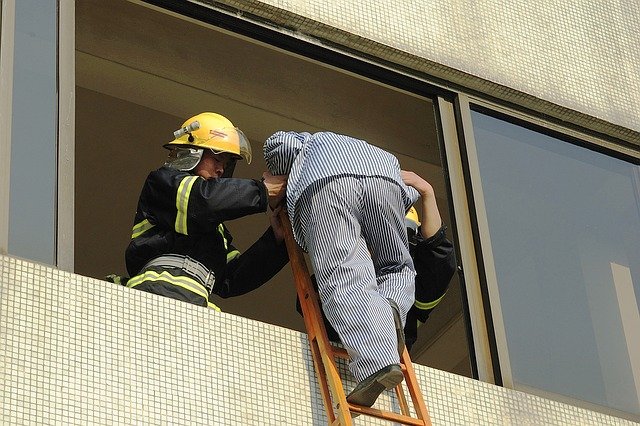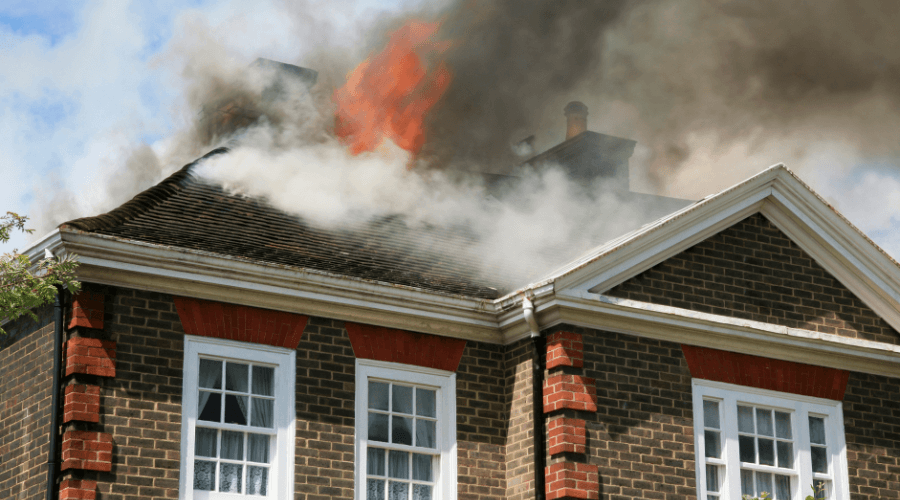A fire escape plan for your home and your family is an important but sadly overlooked part of home safety. We stick a few smoke detectors up on a few ceilings, and we think: job done.
But fire safety at home should go much further than this, and a fire escape plan that everyone will ensure everyone knows what to do, and where to go in the event of a fire in your home.
Have you ever discussed a fire escape plan for your home with your family or the people you live with?
In truth, most of us haven’t even thought about it. It’s one of those things that will never happen to us.
Don’t simply assume others in your household will automatically know what to do in the event of a fire, especially if you have children or vulnerable people in the household.
In this article, I will help you formulate and discuss a fire escape plan with your household today, ensuring everyone knows what to do and where to go in the event of a fire in your home.
Table of Contents
Official Fire Escape Advice
Here is the official advice, which is Government backed and is the same across all fire services across the United Kingdom.
On discovering a fire or hearing a fire alarm:
- Get Out.
- Stay Out.
- Call 999 as soon as it is safe to do so.
If you can, shut doors behind you on your way out to help slow the spread of the fire.
And here is what you should not do:
- Re-enter the building for any reason.
- Try and fight the fire yourself, even if you have a fire extinguisher.
- Go back and save any possessions.
Your Fire Escape Plan
Before you have a plan to escape, you need a proper, robust early warning fire alert system installed in your home that is fit for puropose.
That means smoke and heat detectors installed in the relevant places in home.
Here’s some articles on smoke and heat detectors that you should read (opens in a new tab so you can continue reading this article).
- UK Top 3: Heat Detectors For Kitchens
- UK top 3: Interlinked Smoke Detectors
- Interlinked Smoke AND Heat Detectors (Scottish Law Compliant)
Your fire escape plan should be short and simple, with no need to over complicate things.
So let’s keep it very simple:
First, know who is doing what.
If you people who will need assistance in your property, like small children, elderly or people with disabilities, have a plan on who is going to assist who.
The general advice is to leave your property in the exact same way you normally enter it, or by the quickest, easiest way.
If that exit is blocked by smoke or fire, then a second exit plan should be in place. If you are trapped upstairs, what is the best window to get out of? Is there a window that leads to a roof that you can escape onto?
If all exits are blocked, you and your household should know exactly what to do to keep safe until the fire service arrive:
Shut the door of the room you are in, call 999, block the bottom of the door using sheets or towels, and go to the window shouting ‘Help fire!’
Everyone in your household should know this, and be familiar with your specific fire escape plan for your specific property layout.
Getting Out Easily

It is crucial that all access to doors and windows are left free and unobstructed.
It is also crucial that any locking systems, bolts or any security devices fitted to doors or windows are easily and quickly operated from the inside.
This means that any keys that are required to exit a door or window should be left in the immediate vicinity of that door or window, either on hooks, on the windowsill (if you have small children, keep keys out of reach of them, but easily within reach for you).
Now, about that window that has been broken in your back bedroom for a number of years. You know, the window that should open all the way out, but only opens a couple of inches due to the faulty hinge arm?
If you need to escape through that window one day, that fault will seriously impede you and your family escaping.
So for any fire escape windows that are broken in your property, get them fixed as a matter of urgency.
Biggest Risk Is Whilst Asleep
The biggest risk of fire and becoming trapped in a fire in your home is whilst you are asleep.
That is why it is absolutely imperative that your home is equipped with working smoke detectors and heat detectors. Ideally, you should have linked smoke detectors, so if an alarm sounds in one part of the house, all other alarms will also sound.
(READ: UK Top 3: Best Linked Smoke Detectors)
Those detectors will alert you to a fire quickly, and will save your life.
Even a basic, cheap smoke detector is better than nothing, available from places like Amazon, most big supermarkets and DIY stores.
Flats & Multi Occupancy
By law, flats and multi occupancy residencies should have a working fire alarm system that covers the whole building.
They should also have an evacuation plan with clear green signs and even fire extinguishers present in communal areas to assist with your fire escape plan.
But although these are present, do you actually know the details of this plan?
Make yourself familiar with this plan (signs should be up in communal areas detailing the plan), and make yourself familiar with any fire escape routes such as location of staircases.
Remember, never be tempted to use a lift in the event of a fire, always use the emergency stairs no matter how high up you are.
Educating Children
Children should be taught about the dangers of fire from the earliest age possible.
We naturally teach children from a very early age about heat and what is hot, like teaching them never to go near the oven, or fireplace.
But not many think to teach them about actual fires in their own house.
Fire safety can be a delicate matter for younger children as of course, we don’t want to frighten them or scare them. Well known cartoon characters can help get the message across in a fun, stimulating and educational manner, like this Fireman Sam video for instance:
How you teach your children is up to you. They will of course, get fire safety education at school.
But it is still important to teach and chat to them about what to do and what not to do in the event of a fire in the home.
Elderly And Those With Disabilities
Elderly persons and those with disabilities may not be able to get out of a building wthout some form of assistance.
As part of your fire escape plan, you should make them aware of the plan, but if they do need assistance, you should know exactly who is helping them and how they will help them.
Don’t forget to tell them too – if they know who is going to help them in the event of a fire, it will make the evacuation process that little bit smoother.
Read: Can I Get A Free Smoke Detector From The Fire Service?
Smoke Kills
Remember, in an overwhelming amount of residential property fires, it’s not actually the heat or the fire that kills.
It’s the smoke inhallation that causes people to become incapacitated. Smoke is toxic, it will get into the lungs, and will prevent oxygen circulating through your body.
This causes the body to shut down muscles and organs, and leads to unconsciousness, and then ultimately, death either by smoke inhallation or when the fire finally reaches them and they perish.
An unconscious person cannot get themselves to safety.
That is why it is so, so important to have fully functioning smoke detectors in your property.
Reducing Risk
To reduce the risk of fire injuring or causing death to you and your family, follow these simple steps:
- At the very minimum, install smoke detectors on each level of your property, especially on landings outside sleeping areas, and in hallways. (Read: Best Locations For Smoke Detectors)
- Even better, install linked smoke detectors throughout your property. If one alarm activates, they all activate.
- Install heat detectors in your kitchen.
- Formulate and discuss fire escape plans with every member of your household – frequently. Make sure everyone knows what to do, and where to go on discovery of a fire or alarm activation.
There’s really no mystery around this, the steps above are simple and straightforward.
The cost of a basic smoke detector is less than a couple of Starbuck coffees.
The cost of a more advanced system is the cost of a couple of takeaways.
Reduce the risk to you and your family today. Don’t wait. Stay Safe.
Your Comments
Let me know in the comments section below of your experiences with fires in a residential property.
Let me know how you approach a fire escape plan with your family, and how you share it with your family.
And please, share any of your best practices and tips with our readers by using the comments section below.
Stay Safe. Stay Secure.


